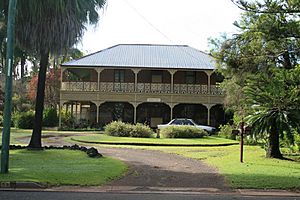Eskdale, Maryborough facts for kids
Quick facts for kids Eskdale |
|
|---|---|

Eskdale, from NW, 2009
|
|
| Location | 53 Pallas Street, Maryborough, Fraser Coast Region, Queensland, Australia |
| Design period | 1840s–1860s (mid-19th century) |
| Built | c. 1864–1920s |
| Built for | James Dowzer |
| Architectural style(s) | Victorian Filigree, Queenslander |
| Official name: Eskdale | |
| Type | state heritage (built, landscape) |
| Designated | 21 October 1992 |
| Reference no. | 600706 |
| Significant period | 1860s–1920s (fabric, historical) |
| Significant components | pathway/walkway, carriage way/drive, residential accommodation – main house, tank – water (underground), garden – bed/s, trees/plantings, lawn/s, conservatory / glasshouse / greenhouse, service wing, garden/grounds, lead light/s, garden edging/balustrades/planter boxes |
| Lua error in Module:Location_map at line 420: attempt to index field 'wikibase' (a nil value). | |
Eskdale is a heritage-listed house located at 53 Pallas Street in Maryborough, Australia. It was built around 1864 and has a rich history. This beautiful old home is listed on the Queensland Heritage Register, which means it's protected for its historical importance.
Contents
History of Eskdale House
Building the House
Eskdale was built around 1864 for James Dowzer. He was an important person in Maryborough and even served as the city's third Mayor. He might have designed the house himself!
The land for Eskdale was bought by James Dowzer and John Pursers. They planned to build a large, two-story brick house. Bricks were made right on the property using local clay. Even the nails used were handmade!
The wood inside, like the floors and doors, came from local cedar trees. This shows how people built things with materials found nearby back then.
Early Owners and Naming Eskdale
James Dowzer moved away in 1868. Then, a lawyer named Edward Corser bought Eskdale. His family moved in even before the house was fully finished.
They named it "Eskdale" to remember a beautiful place in England called Eskdale in the Lake District. It was a way to bring a piece of their old home to Australia.
The Corser Family's Time
Edward Corser passed away in 1874. His son, Edward Bernard Corser, then owned the house. Edward Bernard Corser became a very important person in Maryborough.
He was a successful businessman and later a politician. He served in both the Queensland Parliament and the Australian Parliament. He lived at Eskdale until he passed away in 1928.
His son, Edward Stewart Corser, owned Eskdale until 1961. The house stayed in the Corser family until 1975.
Changes to the House Over Time
Over the years, Eskdale has had some changes. Around 1920, pretty lead light windows were added. The ceilings inside were also decorated with pressed metal.
The original roof was made of slate. But a big hail storm in 1966 damaged it. So, a new iron roof was put on. The verandahs, which are covered porches, also had their roofs changed.
The fancy cast iron railings on the verandahs are special. They were likely made in Maryborough itself! This design is even famous in books about Australian ironwork.
What Eskdale Looks Like
Eskdale is a large, two-story brick house. It sits on Pallas Street in Maryborough. It has a classic, balanced design, like many old homes from the 1800s.
Outside Features
The outside walls are very thick, about 18 inches (45 cm) thick! The roof is made of corrugated iron. Wide verandahs wrap around three sides of the house on both levels.
These verandahs are supported by timber posts with decorative metal brackets. The upper level has beautiful cast iron panels as railings. The front of the house is very neat and balanced. It has a central doorway with double timber doors and large windows on either side.
Inside the House
When you walk in, you enter a hall with an archway and a staircase. The walls are painted a soft green. They have decorative stencils that look like designs from the late 1800s.
The front door has lovely lead-light windows around it. Another lead-light window is on the staircase landing. All the main wooden parts inside, like the stairs and door frames, are made from local red cedar wood.
On the ground floor, there's a big living room. It has polished wooden floors and a decorative pressed metal ceiling from the 1920s. There's also a large fireplace. On the other side of the hall, you'll find the dining room and kitchen. The dining room has built-in cedar bookcases.
Gardens and Grounds
Eskdale is set in lovely gardens with old trees. You can still see some original outdoor features. There's a circular driveway at the front.
On the northern side, there's a garden with geometric shapes and concrete paths from around 1915. You can also spot an old shed that used to be a glasshouse.
A cool feature is the underground brick water tank. It's 20 feet (6 meters) deep! This tank collects rainwater from the roof. Similar tanks were built around the same time at other old houses nearby.
Why Eskdale is Important
Eskdale is listed on the Queensland Heritage Register for several reasons:
- It shows how Queensland's history developed. Eskdale shows how Maryborough grew in the 1860s. It also shows how important people in early towns built grand homes.
- It's a great example of its type. The house is a well-preserved example of a large, two-story home from the 1860s in regional Queensland. Its gardens and other structures also show how these old homes worked.
- It has aesthetic value. Eskdale is a beautiful house with nice decorative details and a balanced design, all set in a lovely garden.
- It's connected to important people. Eskdale has a special link to James Dowzer and Edward Bernard Corser. Both were very important figures in Queensland's history.


